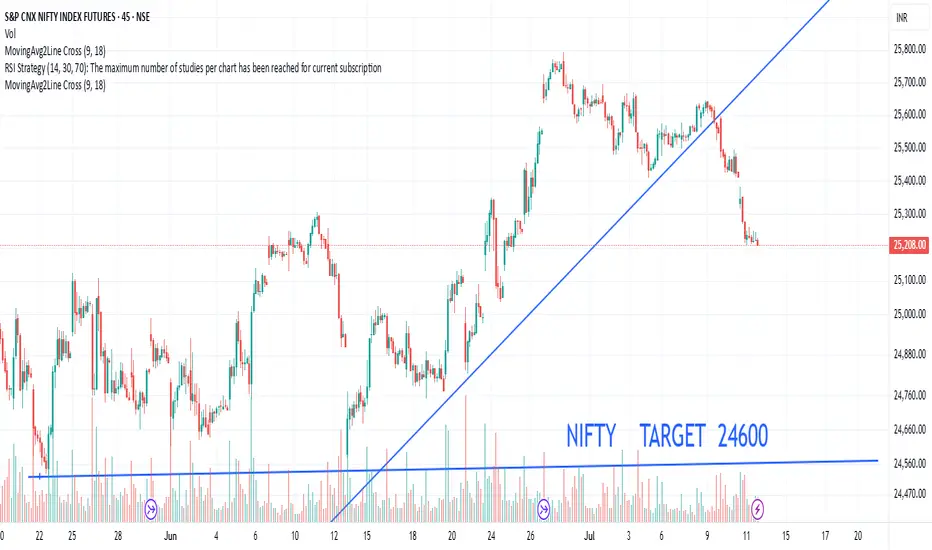NIFTY 50's Current Status and Short-Term Outlook (as of July 11, 2025)
As of its last close on July 11, 2025, the NIFTY 50 index concluded at 25,149.85. The index is currently exhibiting a bearish trend in the short term, having closed below its 20-day moving average (20-DMA). This breach suggests potential further downside, with immediate support levels identified around 25,000, followed by 24,900. Conversely, immediate resistance is anticipated in the 25,300–25,350 range.
Factors Influencing NIFTY 50's Recent Performance
The recent decline in NIFTY 50's performance can be attributed to a combination of factors:
Weakness in IT and Auto Sectors: Notably, the IT and auto sectors have experienced significant declines. This downturn was partly triggered by disappointing Q1FY26 earnings from TCS, which dampened investor sentiment.
Global Market Sentiment: Global cues have been mixed, with US markets showing strength while Asian markets exhibit a more cautious trend. This divergence, coupled with ongoing geopolitical uncertainties, has contributed to market volatility.
Trade Deal Jitters: Uncertainty surrounding the India-US trade deal and the potential impact of new tariffs announced by the US have also weighed on investor sentiment.
Expert Predictions and Targets for NIFTY 50
Several experts have weighed in on NIFTY 50's potential trajectory:
Short-Term Bearish Outlook: Many experts anticipate continued weakness in the short term, with potential downside targets around 25,000 and 24,900.
August Target of 25,800: Despite the current bearish trend, some experts, like I-Sec's Dharmesh Shah, maintain a positive outlook, expecting the index to reach 25,800 in August.
Long-Term Bullish Scenario: Looking further ahead, JPMorgan projects a potential bull case scenario where NIFTY 50 could reach 30,000 by April 2026, driven by an anticipated earnings boost.
As of its last close on July 11, 2025, the NIFTY 50 index concluded at 25,149.85. The index is currently exhibiting a bearish trend in the short term, having closed below its 20-day moving average (20-DMA). This breach suggests potential further downside, with immediate support levels identified around 25,000, followed by 24,900. Conversely, immediate resistance is anticipated in the 25,300–25,350 range.
Factors Influencing NIFTY 50's Recent Performance
The recent decline in NIFTY 50's performance can be attributed to a combination of factors:
Weakness in IT and Auto Sectors: Notably, the IT and auto sectors have experienced significant declines. This downturn was partly triggered by disappointing Q1FY26 earnings from TCS, which dampened investor sentiment.
Global Market Sentiment: Global cues have been mixed, with US markets showing strength while Asian markets exhibit a more cautious trend. This divergence, coupled with ongoing geopolitical uncertainties, has contributed to market volatility.
Trade Deal Jitters: Uncertainty surrounding the India-US trade deal and the potential impact of new tariffs announced by the US have also weighed on investor sentiment.
Expert Predictions and Targets for NIFTY 50
Several experts have weighed in on NIFTY 50's potential trajectory:
Short-Term Bearish Outlook: Many experts anticipate continued weakness in the short term, with potential downside targets around 25,000 and 24,900.
August Target of 25,800: Despite the current bearish trend, some experts, like I-Sec's Dharmesh Shah, maintain a positive outlook, expecting the index to reach 25,800 in August.
Long-Term Bullish Scenario: Looking further ahead, JPMorgan projects a potential bull case scenario where NIFTY 50 could reach 30,000 by April 2026, driven by an anticipated earnings boost.
Disclaimer
The information and publications are not meant to be, and do not constitute, financial, investment, trading, or other types of advice or recommendations supplied or endorsed by TradingView. Read more in the Terms of Use.
Disclaimer
The information and publications are not meant to be, and do not constitute, financial, investment, trading, or other types of advice or recommendations supplied or endorsed by TradingView. Read more in the Terms of Use.
